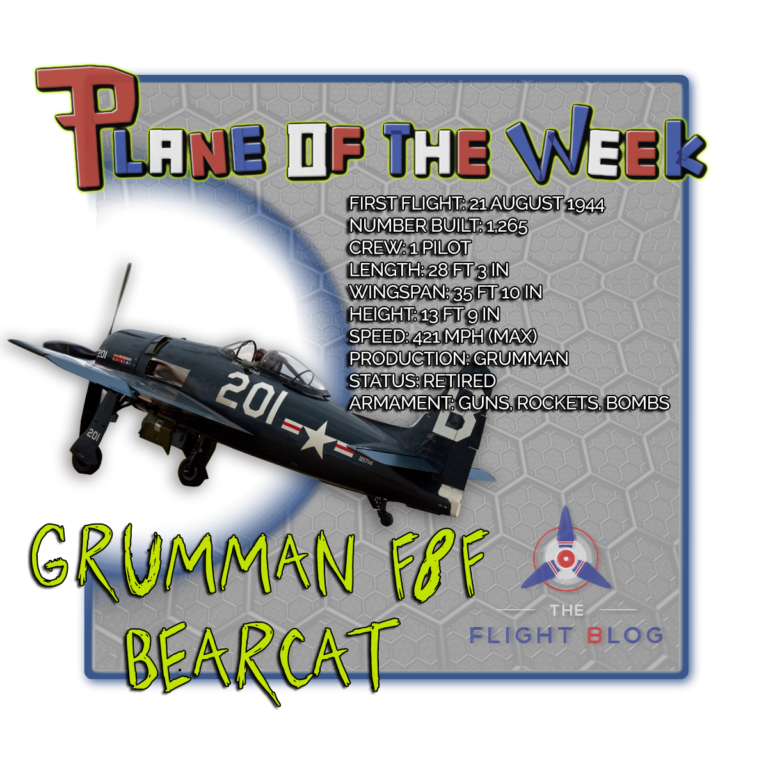Plane of the Week: Grumman F8F Bearcat
By on Dec 30th 2016
The bearcat, also known as the binturong, is a viverrine mammal from Southeast Asia-it is closely related to neither bears nor cats. The Grumman F8F Bearcat, on the other hand, is a single-engine carrier-based fighter aircraft that was introduced late into WWII.
The Bearcat aircraft concept was conceived when Battle of Midway veteran F4F Wildcat pilots and Grumman Vice President Jake Swirbul met at Pearl Harbor on June 23, 1942. During the course of the meeting, Lieutenant Commander Jimmie Thach emphasized the importance of -climb rate- in a good fighter plane.
Besides climb performance, another goal for the aircraft was that it should be able to operate from escort carriers. At the time, this was limited to the F4F Wildcat and the Grumman F6F Hellcat (which was too large and too heavy).
After analyzing carrier warfare in the Pacific Theater of Operations for over a year, Grumman began to develop the G-58 Bearcat in late 1943.
The F8F was heavily influenced by the larger F6F. It has been debated whether or not if the Focke-Wulf FW 190 influenced the design of the Bearcat.

Design & Development
Climb performance is related to the power-to-weight ratio; to maximize performance, aircraft developers look to use the most powerful engine available with the lightest possible airframe. The Pratt & Whitney R-2800 engine (which provided 2,00 horsepower) was the most powerful engine available. Grumman used this engine in both the Wildcat and the Bearcat. For the Bearcat, however, the fuselage was cut by about 5 feet as well as vertically behind the cockpit. Also compared to the Hellcat, the Bearcat had a vertical stabilizer of similar height, but increased aspect ratio, which made it look thinner. The main wing had similar span, but lower thinness.
While the Hellcat used a 13'1- 3-bladed Hamilton Standard propeller, for size reduction purposes, the Bearcat instead used a 12' 7- Aeroproducts four-bladed propeller. Initial design plans called for the Bearcat to have a maximum weight of 8,750 lbs. fully-loaded. Due to the structure, however, this would have been impossible. Instead, the aircraft was developed with an empty weight of 7,070 lb. and a loaded weight of 9,600 lb.
Production & Operation
The Navy placed a production order for 2,023 aircraft on October 6, 1944 (based on second prototype). In Febuary 1945, they awarded another contract to General Motors for 1,876 slightly modified aircraft. The GM aircraft (designated F3M-1) had a R-2800-34W engine and a small increase in fuel capacity.
The F8F prototypes first flew August 21, 1944, only 9 months after they were ordered. The first production aircraft were operational by May 21, 1945, but WWII was over before they ever saw combat service.
The first time the Bearcat saw combat was during the French Indochina War; nearly 200 F8Fs were delivered to the French in 1951. When the war was over in 1954, 28 surviving bearcats were sent to the Republic of Vietnam and entered service in 1956. The VNAF retired their Bearcats in 1963 in favor Douglas A-1 Skyraiders and North American T-28 Trojans.
Besides their use in combat, Bearcats have also been a popular aircraft for air racing. In 1964, Mira Slovak won the first Reno Air Race in a stock Bearcat (sponsored by Bill Stead). Lyle Shelton also dominated the event for several decades in Rare Bear, a highly modified F8F.
The F8F Bearcat was Grumman's final piston engine fighter aircraft and was used by US navy, US Marine Corps, and air forces of other nations. Modified versions of the F8F have broken speed records for piston-engine aircraft and are popular among warbird owners.







